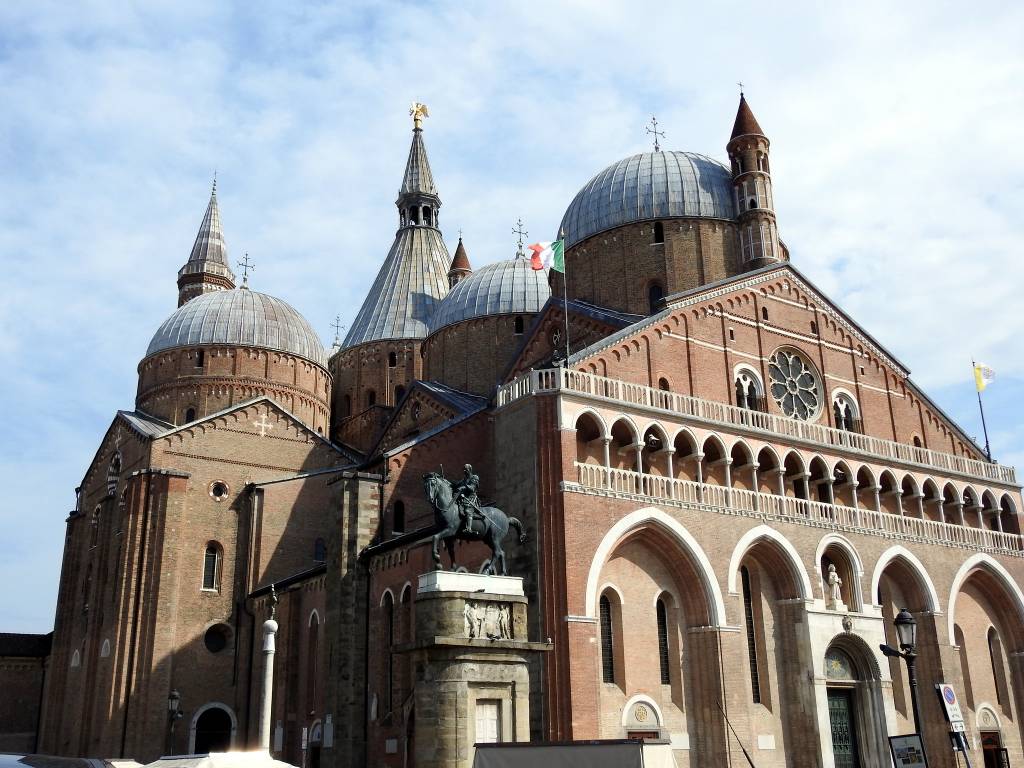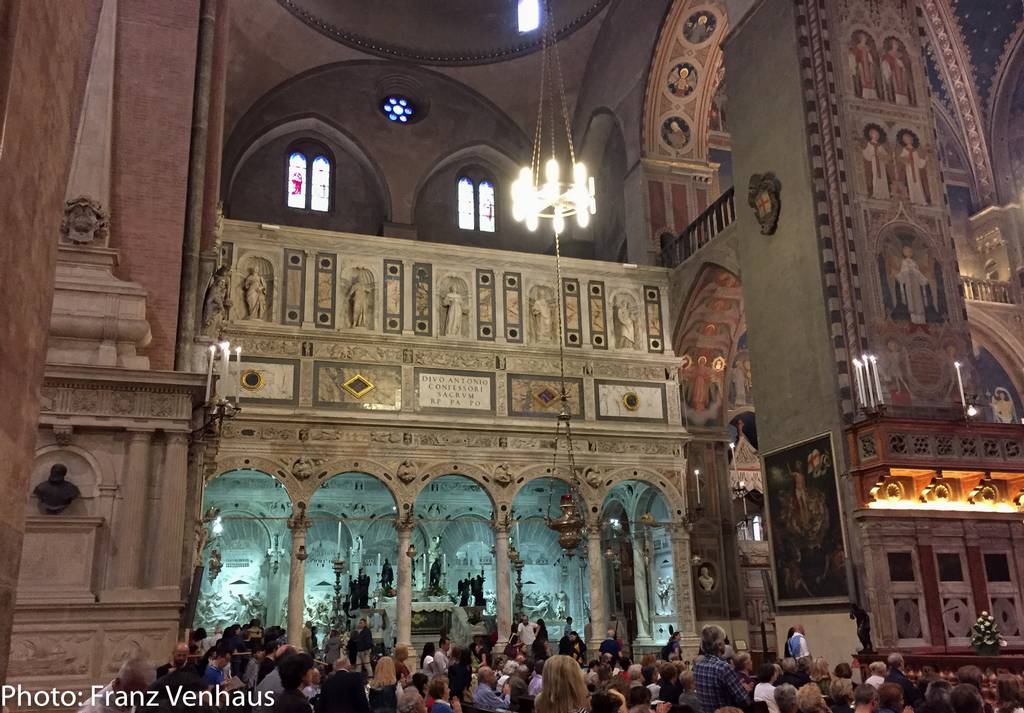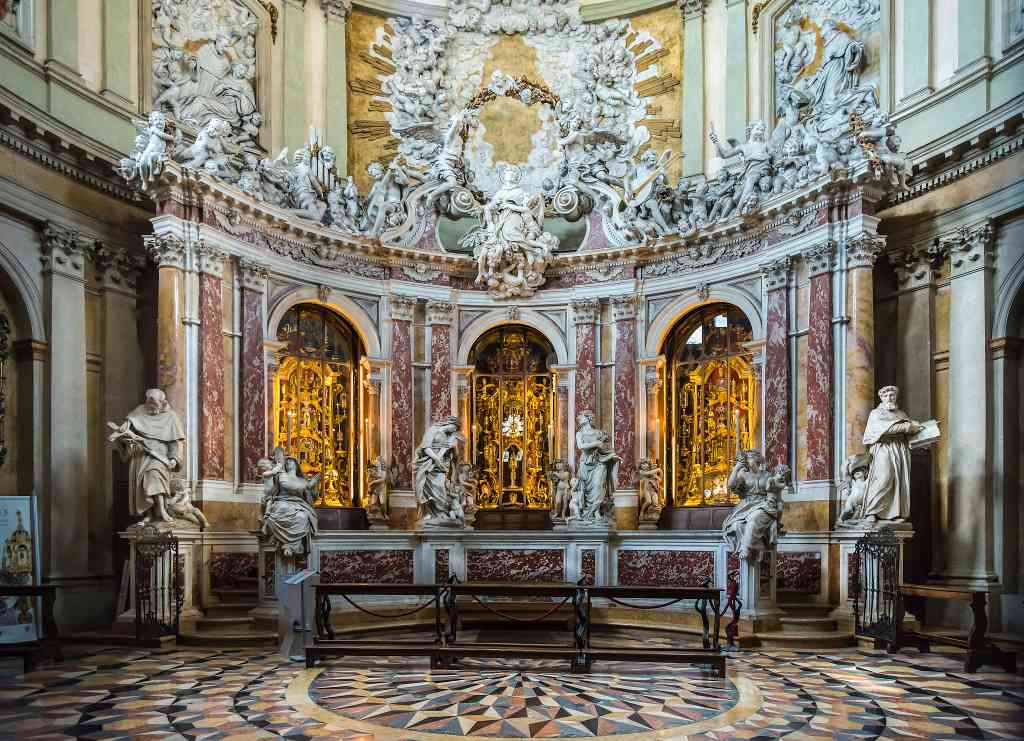Basilica of Saint Anthony
One of the most famous and visited sanctuaries in the world and a testament of art decorated by Giotto, Giusto de' Menabuoi, Altichiero da Zevio, and Jacopo Avanzi

The Basilica del Santo, or Basilica of Saint Anthony, was built between 1232 and 1310, incorporating the small church of Santa Maria Mater Domini, where the mortal remains of Friar Anthony had been initially buried, who died 13 June 1231 at the gates of Padua.
After the death of Friar Anthony, the church soon became a pilgrimage destination and the site of miraculous phenomena; Anthony was canonised by Pope Gregory IX just one year after his death, and the citizens of Padua decided to build a Basilica capable of hosting the growing flow of pilgrims who flocked to pray at his tomb.
Today, the Basilica del Santo is one of the most famous and visited sanctuaries in the world, an international place of worship for an average of 6.5 million visitors a year. Friar Anthony is known and venerated worldwide as Saint Anthony of Padua.
Located in Piazza del Santo, a few hundred meters from Prato della Valle, the Basilica is also an important monument in the history of architecture and art and of fourteenth-century fresco painting in particular.
The Basilica is characterised by the presence of different elements and styles blended harmoniously: the facade is in Romanesque style, with exposed brick walls, the rose window, arches, and buttresses are in Gothic style; the roof is made up of eight Byzantine domes covered in lead and two thin and slender bell towers reminiscent of Islamic minarets.
The lunette of the central portal is a copy of the fresco painted by Andrea Mantegna and now preserved in the Antonian Museum. The three bronze doors on the main facade are the work of Camillo Boito.
The interior
The interior of the Basilica has the form of a Latin cross, divided into three naves and with galleries on the upper part of the walls. The counter-facade of the Basilica houses a large fresco by Pietro Annigoni in 1985, which depicts Saint Anthony preaching from the walnut. In the right aisle, there is the Gattamelata Chapel, which preserves the tomb of the leader Erasmo da Narni.
From the ambulatory’s centre is possible to access the Chapel of the Relics or the Treasury Chapel. The Chapel was built starting from 1691 in Baroque style by Filippo Parodi, a pupil of Bernini. Here the most precious relics of Saint Anthony are preserved: the Reliquary of the incorrupt tongue of the Saint, a masterpiece of 1434 by Giuliano da Firenze, the Reliquary of the Chin of the Saint and that of the laryngeal cartilages and the Memoirs of the Saint, the cassock, the tombstone original and other finds placed after the survey carried out in 1981.
Immediately after is the Chapel of Saint Anthony or the Chapel of the Ark, the real heart of the Basilica, where the tomb of the Saint is kept. The chapel owes its current appearance to the sixteenth-century layout designed by Andrea Briosco. Giovanni Maria Falconetto made the stuccoes on the ceiling. The altar is the work of Tiziano Aspetti from 1593, which contains the remains of the saint in the green marble ark. The statues placed on the altar are the work of Tullio Lombardo. The high-reliefs on the walls depicted scenes from the life and miracles of the Saint and were made by Girolamo Campagna, Jacopo Sansovino, and Tullio Lombardo.
The High Altar
At the centre of the Basilica of Saint Anthony stands the High Altar, which collects the over thirty works created by Donatello between 1443 and 1450, representing an absolute masterpiece of Renaissance art. Camillo Boito devised the current layout in 1895 in an attempt to reconstruct the original design by Donatello, which was irretrievably lost in 1591.
The seven statues depict the Madonna and Child, surrounded by the city’s patrons, Saint Justina, Saint Daniel, Saint Louis, and Saint Prosdocimus with Saint Francis and Saint Anthony. Behind the statue of the Virgin stands the large bronze Crucifix, a masterpiece of expressiveness in the suffering figure of Christ.
Four bas-reliefs decorate the main altar and illustrate the Miracles of Saint Anthony; fourteen reliefs represent putti: musician angels and singers. Four smaller panels contain the symbols of the evangelists and a relief made of Nanto stone that adorns the back of the main altar and depicts the Lamentation of the dead Christ.
The frescoes of the fourteenth century
The Basilica is a significant protagonist of the history of the Paduan fresco of the fourteenth century. Authors of series of frescoes of the highest quality have made their mark in the Basilica: Giotto, Giusto de' Menabuoi, Altichiero da Zevio, Jacopo Avanzi, and Jacopo da Verona.
The Benediction Chapel, where the faithful can have their objects blessed, contains traces of a precious fresco cycle created by Giotto. In the fourteenth century, the entire chapel must have been covered in frescoes; however, the work carried out in 1727 led to repainting a large part of the original surfaces.
Another work that has very recently been attributed to Giotto is found in the Chapel of the Black Madonna, a fresco behind the statue of the Virgin and Child set within a niche of the altar. This is one of Giotto’s earliest works in Padua, dated from 1302-1303, before the fresco cycle in the Scrovegni Chapel. The chapel is the surviving part of the ancient church of Santa Maria Mater Domini that was integrated into the construction of the Basilica. The Statue of the Dark Madonna, with dark hair colour and olive skin tone, hence the chapel’s name, is located above the altar is the work of French artist Rinaldino Puydarrieux from 1396.
The Chapter Hall in the Monastery of Saint Anthony and the passageway that links the Magnolia and Novitiate Cloisters were also initially decorated with frescoes by Giotto, of which only a few fragments remain today. It was perhaps the Friars Minor who called Giotto to the city at the beginning of the fourteenth century to work on parts of the Basilica complex.
The Saint James Chapel, built in the Gothic style in the fourteenth century by the architect and sculptor Andriolo de Santi, was frescoed with stories of Saint James by Altichiero da Zevio and Jacopo Avanzi. The splendid Crucifixion is considered Altichiero's masterpiece – this is the first time an artist used such daring trompe l’oeil, developing the pictorial space as an extension of the actual architectural space. Both artists had arrived in Padua around 1370 to work on interiors of the Carrarese Palazzo; however, none of their frescoes there survived, so this chapel is the sole evidence of the fruits of their collaboration. The chapel construction and decoration were commissioned by Bonifacio Lupi di Soragna, a member of an aristocratic family with very close links to the Carrarese court.
The small Chapel of the Blessed Luca Belludi was added in the second half of the fourteenth century to the body of the Basilica and dedicated to the companion and successor of Saint Anthony. The chapel was frescoed in 1382 under the commission of the Conti family, one of the oldest aristocratic houses in Padua, by the Florentine artist Giusto de' Menabuoi, the author of the beautiful frescoes that decorate the Baptistery of the Padua Cathedral.
We welcome all contributions, no matter how small. Even a spelling correction is greatly appreciated.
All submissions are reviewed before being published.
Continue to changelog-

© 'Basilica di Sant'Antonio' by Bex Walton is licensed under CC BY 4.0 Attribution copied to clipboard Failed copying attribution to clipboard -

© '160529_Padua_Padova_Basilica-0933.jpg' by FranzVenhaus is licensed under CC BY-ND 4.0 Attribution copied to clipboard Failed copying attribution to clipboard -

© 'Sant'Antonio (Padua) - Cappella del beato Luca Belludi - Giusto de' Menabuoi' by Didier Descouens is licensed under CC BY-SA 4.0 Attribution copied to clipboard Failed copying attribution to clipboard -

We welcome all contributions.
All submissions are reviewed before being published.
We welcome all contributions, no matter how small. Even a spelling correction is greatly appreciated.
All submissions are reviewed before being published.
Continue to changelogWe welcome all contributions, no matter how small. Even a spelling correction is greatly appreciated.
All submissions are reviewed before being published.
Continue to changelogWe welcome all contributions, no matter how small. Even a spelling correction is greatly appreciated.
All submissions are reviewed before being published.
Continue to changelogCategory
Cost
-
Once the humble dwelling of Saint Anthony, the Friary developed over the centuries into the five splendid cloisters located on the southern side of the Basilica.
-
69 m
Piazza del Santo is a miniature citadel sheltered by the splendid masterpieces of the Oratory of Saint George and the Gattamelata statue.
-
An aristocratic family mausoleum decorated by Altichiero da Zevio with frescoes depicting scenes from the Life of Christ and of Saint George
-
The oldest Heritage Garden in the world, home to over 6,000 different plant specimens and the futuristic Garden of Biodiversity
-
The Giardino Treves de' Bonfili is one of Padua’s most renowned historical gardens, a hidden jewel of architectural and landscape creation by Giuseppe Jappelli.




